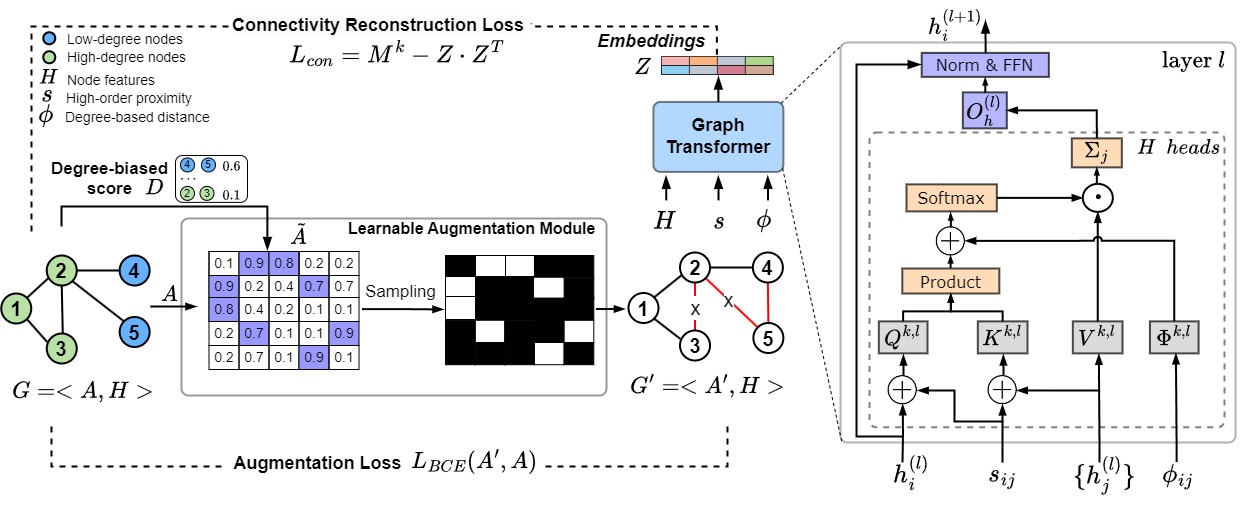Community-aware Graph Transformer (CGT) is a novel Graph Transformer model that utilizes community structures to address node degree biases in message-passing mechanism and developed by NS Lab, CUK based on pure PyTorch backend. The paper is available on arXiv.
Recent augmentation-based methods showed that message-passing (MP) neural networks often perform poorly on low-degree nodes, leading to degree biases due to a lack of messages reaching low-degree nodes. Despite their success, most methods use heuristic or uniform random augmentations, which are non-differentiable and may not always generate valuable edges for learning representations. In this paper, we propose Community-aware Graph Transformers, namely CGT, to learn degree-unbiased representations based on learnable augmentations and graph transformers by extracting within community structures. We first design a learnable graph augmentation to generate more within-community edges connecting low-degree nodes through edge perturbation. Second, we propose an improved self-attention to learn underlying proximity and the roles of nodes within the community. Third, we propose a self-supervised learning task that could learn the representations to preserve the global graph structure and regularize the graph augmentations. Extensive experiments on various benchmark datasets showed CGT outperforms state-of-the-art baselines and significantly improves the node degree biases.

The overall architecture of Community-aware Graph Transformer.
We used six publicly available datasets, which are grouped into three different domains, including citation network (Cora, Citeseer, and Pubmed datasets), Co-purchase network networks (Amazon Computers and Photo datasets), and reference network (WikiCS). The datasets are automatically downloaded from Pytorch Geometric.
The source code was developed in Python 3.8.8. CGT is built using Torch-geometric 2.3.1 and DGL 1.1.0. Please refer to the official websites for installation and setup.
All the requirements are included in the environment.yml file.
# Conda installation
# Install python environment
conda env create -f environment.yml
The following Options can be passed to exp.py:
--dataset: The name of dataset inputs. For example: --dataset cora
--lr: Learning rate for training the model. For example: --lr 0.001
--epochs: Number of epochs for pre-training the model. For example: --epochs 500
--run_times_fine: Number of epochs for fine-tuning the model. For example: --run_times_fine 500
--layers: Number of layers for model training. For example: --layers 4
--drop: Dropout rate. For example: --drop 0.5
--dims: The dimmension of hidden vectors. For example: --dims 64.
--k_transition: The number of transition step. For example: --k_transition 3.
--alpha: Hyperparameters for degree-related score. For example: --alpha 0.1.
--beta: Hyperparameters for adjacency matrix score. For example: --beta 0.95.
--alpha_1: Hyperparameters for transition construction loss. For example: --alpha_1 0.5.
--alpha_2: Hyperparameters for feature construction loss. For example: --alpha_2 0.5.
--alpha_3: Hyperparameters for augmentation loss. For example: --alpha_3 0.5.
The source code contains both pre-training and fine-tuning processes. The following commands will run the pre-training process and fine-tune the CGT on Cora dataset for both node classification and clustering tasks.
python exp.py --dataset cora
📃 Paper on arXiv:
📈 Experimental results on Papers With Code:
📝 Blog post on Network Science Lab:
Please cite our paper if you find CGT useful in your work:
@misc{hoang2023mitigating,
title={Mitigating Degree Biases in Message Passing Mechanism by Utilizing Community Structures},
author={Van Thuy Hoang and O-Joun Lee},
year={2023},
eprint={2312.16788},
archivePrefix={arXiv},
primaryClass={cs.LG}
}
Please take a look at our structure-preserving graph transformer model, UGT, which has as high expessive power as 3-WL, together.




